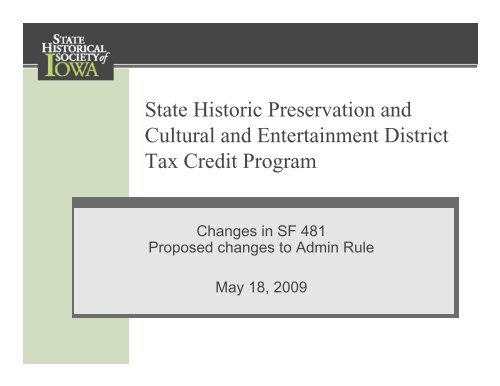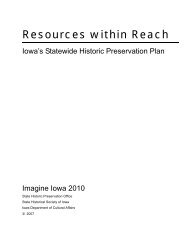State Historic Preservation and Cultural and Entertainment District ...
State Historic Preservation and Cultural and Entertainment District ...
State Historic Preservation and Cultural and Entertainment District ...
Create successful ePaper yourself
Turn your PDF publications into a flip-book with our unique Google optimized e-Paper software.
<strong>State</strong> <strong>Historic</strong> <strong>Preservation</strong> <strong>and</strong><br />
<strong>Cultural</strong> <strong>and</strong> <strong>Entertainment</strong> <strong>District</strong><br />
Tax Credit Program<br />
Changes in SF 481<br />
Proposed changes to Admin Rule<br />
May 18, 2009
Agenda for May 18, 2009 – 1:30-3:00pm<br />
1. Summary of legislation & proposed rules<br />
2. Change in yearly cap & fund allocations<br />
3. Where & when available credits flow<br />
4. Sequencing <strong>and</strong> review prioritization<br />
5. Readiness tests: project start/end<br />
6. Shifting time for claiming the credits<br />
7. Fee structure<br />
8. General questions & comments
1. Summary of Legislation<br />
• Raises the yearly cap to $50 million!<br />
• Creates two new funds <strong>and</strong> dictates where<br />
<strong>and</strong> when they flow, if they are not used:<br />
• disaster recovery fund<br />
• new permanent job fund<br />
• Codifies readiness tests for project start/end<br />
for all projects (new <strong>and</strong> old)<br />
• Shifts timing on when credits can be claimed<br />
• Other code corrections & clarifications
Summary of Proposed Rule Changes<br />
• Clarifies h<strong>and</strong>ling of small project overruns<br />
• Sets fund self-selection process<br />
• Prioritizes master review sequence list<br />
according to code<br />
• Provides guidance for project start/end<br />
• Clarifies project ab<strong>and</strong>onment & reservation<br />
recapture process<br />
• Clarifies appeal process for eligibility & scope<br />
• Other rule corrections & clarifications
2. Change in Yearly Cap <strong>and</strong> Allocations<br />
Fund<br />
Small Project<br />
CED-GP<br />
Disaster Recovery<br />
New Permanent Jobs<br />
<strong>State</strong>wide<br />
Previous Code<br />
$20 Million<br />
10%<br />
$2 Million<br />
40%<br />
$8 Million<br />
-0-<br />
-0-<br />
50%<br />
$10 Million<br />
New Legislation<br />
$50 Million<br />
10%<br />
$5 Million<br />
30%<br />
$15 Million<br />
20%<br />
$10 Million<br />
20%<br />
$10 Million<br />
20%<br />
$10 Million
Disaster Recovery Fund<br />
• Disaster declared by governor or president beginning<br />
January 1, 2008, <strong>and</strong> thereafter<br />
• Property must be physically impacted by disaster, as<br />
documented in application by:<br />
• Insurance claim<br />
• Paperwork from FEMA, SBA, or eligible lender<br />
• Form signed by county emergency manager, city or<br />
county official, or representative of COG<br />
• Must submit initial application before or during the<br />
first “filing window” that occurs following the 5-year<br />
anniversary of the start date of the disaster’s incident<br />
period (e.g., FEMA-1763-DR declared May 27, 2008<br />
has until July 1913 to apply).
New Permanent Jobs Fund<br />
• Property must be home to 500 new permanent jobs<br />
• Employment base measured on the date the tax<br />
credit is reserved<br />
• New permanent jobs measured two years after the<br />
date the tax certificate is issued; verified by IDED<br />
• Contract between SHPO, applicant, <strong>and</strong> any<br />
leaseholders/tenants, if applicable<br />
• If contract requirements are not met, credits are<br />
repaid to <strong>State</strong>
3. How Available Credits Flow to Other Funds<br />
“If, in any fiscal year, an amount of tax credits … goes unclaimed, the tax<br />
credits shall, during the same fiscal year, be reallocated to ...”<br />
Disaster Recovery<br />
<strong>State</strong>wide<br />
Small Projects<br />
CED-GP<br />
New Permanent Jobs<br />
Available credits transferred in the same<br />
state fiscal year for which the credit is<br />
allocated, essentially as part of yearly<br />
sequencing <strong>and</strong> review of Part 2 applications.<br />
Credits remain in<br />
small project fund.<br />
They no longer<br />
flow to statewide.
Credit Flow <strong>and</strong> Timing of Roll-over<br />
2010 Credits<br />
Disaster Recovery <strong>State</strong>wide Small Projects<br />
Transferred Summer 2009<br />
CED-GP New Permanent Jobs<br />
2011 Credits<br />
Disaster Recovery <strong>State</strong>wide Small Projects<br />
Transferred Summer 2010<br />
CED-GP New Permanent Jobs<br />
2012 Credits<br />
Disaster Recovery <strong>State</strong>wide Small Projects<br />
Transferred Summer 2011<br />
CED-GP New Permanent Jobs
4. Sequencing <strong>and</strong> Review Prioritization<br />
Categories for Master Sequence List<br />
A. “Underfunded” <strong>and</strong> cost overruns<br />
1) Projects underfunded in previous year’s sequencing<br />
2) Projects with final costs over estimated costs<br />
B. Projects submitted during previous filing windows<br />
1) Projects submitted in July 2007 <strong>and</strong> July 2008<br />
2) Projects first submitted in July 2008<br />
3) Projects submitted in July 2007 only<br />
C. New projects
Sequencing <strong>and</strong> Review Prioritization<br />
Review Prioritization<br />
• Category A<br />
• Small Projects, CED-GP, <strong>and</strong> Jobs<br />
• Disaster Recovery<br />
• <strong>State</strong>wide<br />
It is up to you to select<br />
the appropriate fund.<br />
Disaster Recovery <strong>State</strong>wide Small Projects<br />
CED-GP<br />
New Permanent Jobs
5. “Readiness Test”: Project commencement<br />
• Before the end of the state fiscal year in which credits<br />
are reserved (June 30), applicants must notify SHPO<br />
of project start date or receipt of low income housing<br />
tax credit award<br />
• Applicants with projects over $500,000 must include<br />
a CPA statement certifying 10% qualified<br />
rehabilitation costs spent<br />
• If project not started, SHPO recaptures reservation
“Readiness Test”: Project completion<br />
• For projects with credits reserved before<br />
July 1, 2009, property must be placed in service by<br />
June 30, 2011<br />
• For projects with credits reserved July 1, 2009 <strong>and</strong><br />
after, property must be placed in service within 36<br />
months (3 years) of tax credit reservation<br />
• Part 3 must be submitted within 6 months of date<br />
property placed in service<br />
• If project not completed on time, SHPO recaptures<br />
reservation
*Hypothetical* Project Timeline<br />
SFY<br />
2010<br />
SFY<br />
2011<br />
SFY<br />
2012<br />
SFY<br />
2013<br />
Part 3 Submitted<br />
Part 2 Submitted<br />
Part 2 Approved<br />
10% Spent<br />
“Placed in Service”<br />
April 1, 2013<br />
July 1, 2009<br />
Oct. 1, 2009<br />
June 30, 2010<br />
Oct. 1, 2012<br />
Part 3 Approved July 1, 2013<br />
* Based on maximum review periods <strong>and</strong> maximum project start/end dates.
*Hypothetical* Project Timeline<br />
For credits reserved<br />
before July 1, 2009,<br />
“Placed in Service”<br />
June 30, 2011.<br />
SFY<br />
2010<br />
SFY<br />
2011<br />
SFY<br />
2012<br />
SFY<br />
2013<br />
Part 3 Submitted<br />
by Dec 30, 2011.<br />
Part 3 Approved<br />
by March 30, 2012.<br />
* Based on maximum review periods <strong>and</strong> maximum project start/end dates.
6. Shifting time for claiming credits<br />
SFY<br />
2010<br />
2011<br />
2012<br />
Year in which tax credit can be claimed:<br />
First $20 M can be claimed on return for<br />
Tax Year beginning Jan. 1, 2009<br />
Add’l $30 M can be claimed on return for<br />
Tax Year beginning Jan. 1, 2010<br />
First $20 M can be claimed on return for<br />
Tax Year beginning Jan. 1, 2010<br />
Add’l $30 M can be claimed on return for<br />
Tax Year beginning Jan. 1, 2011<br />
First $20 M can be claimed on return for<br />
Tax Year beginning Jan. 1, 2011<br />
Add’l $30 M can be claimed on return for<br />
Tax Year beginning Jan. 1, 2012<br />
This will apply to credits:<br />
already reserved<br />
reserved after July 1*<br />
already reserved<br />
reserved after July 1*<br />
reserved after July 1*<br />
reserved after July 1*<br />
* reservations will be sequentially awarded
Shifting time for claiming credits<br />
• If you have an existing reservation, nothing<br />
changes. Your tax credit certificate, if issued<br />
after July 1, 2009, will indicate the tax year for<br />
which you can claim the credits.<br />
• Applicants with new reservations will know<br />
when they can claim the credit by information<br />
provided in:<br />
• Reservation letter issued after Part 2 review<br />
• Certificate issued upon Part 3 review <strong>and</strong><br />
approval
7. Current Fee Structure<br />
Rehab Cost<br />
Fee<br />
Part 2<br />
Res (1-2) & Barns<br />
Res (1-2) & Barns<br />
Under $50K<br />
$50K +<br />
-0-<br />
$250<br />
Commercial<br />
$500<br />
Part 3<br />
Res (1-2) & Barns<br />
Res (1-2) & Barns<br />
Under $50K<br />
$50K +<br />
-0-<br />
$250<br />
Commercial<br />
Under $50K<br />
$250<br />
Commercial<br />
$50K - $1M<br />
0.5% rehab cost<br />
Commercial<br />
$1M +<br />
$5,000
7. Current Fee Structure<br />
Iowa<br />
Colorado<br />
Kansas<br />
Maryl<strong>and</strong><br />
Michigan<br />
Mississippi<br />
Missouri<br />
Virginia<br />
West Virginia<br />
Part 3<br />
$0 - $5,000<br />
$0 - $750<br />
-0-<br />
-0-<br />
1% of credit<br />
$0 - $5000+ ($2.5M+ cost,<br />
fee is 2% of credit)<br />
$150 - $2,000<br />
2.5% of credit<br />
$100 - $1,500<br />
Part 2<br />
$0 - $500<br />
$0 - $250<br />
$200 - $2000<br />
$10<br />
$25 - $5,000<br />
$100 - $250<br />
-0-<br />
$0 - $1500<br />
$50 - $500
Comments<br />
Written comments may be submitted to:<br />
Elizabeth Foster Hill, Tax Incentives Program Manager<br />
<strong>State</strong> <strong>Historic</strong> <strong>Preservation</strong> Office<br />
600 East Locust<br />
Des Moines, Iowa 50319<br />
Beth.Foster@iowa.gov<br />
Comments must be received by:<br />
Noon on Tuesday, May 26, 2009







